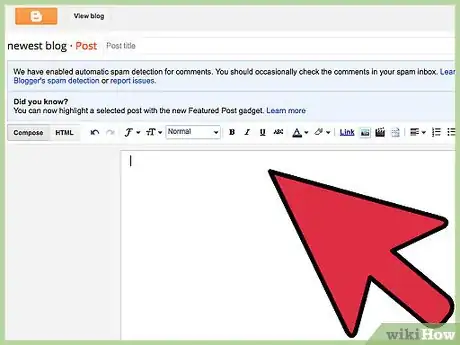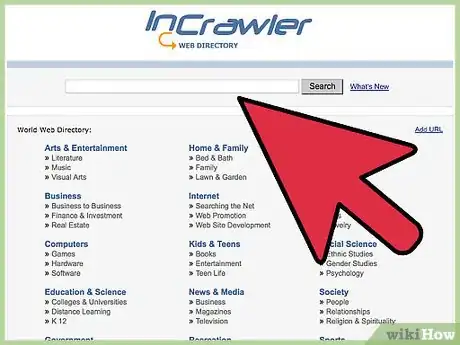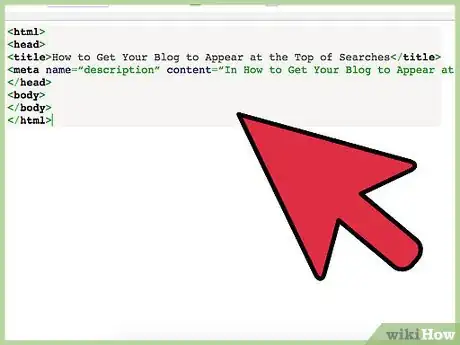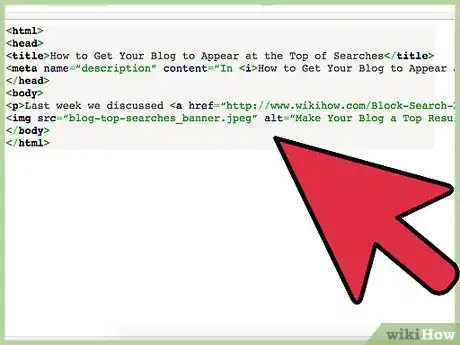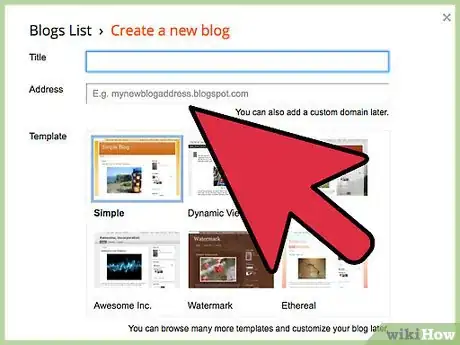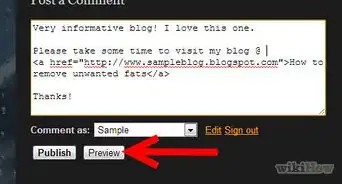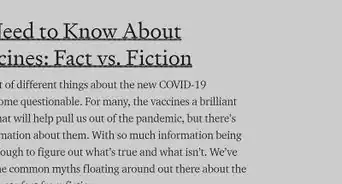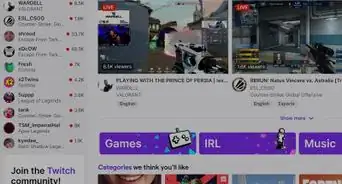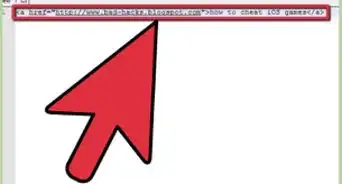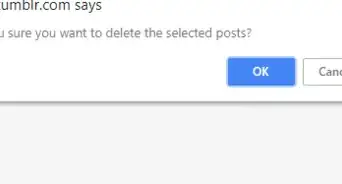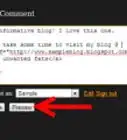This article was written by Melissa Rodriguez and by wikiHow staff writer, Jack Lloyd. Melissa Rodriguez is a Marketing and Advertising Specialist and the Founder of Social Media Relations out of Los Angeles, California. With over 5 years of experience, she specializes in branding, content production, social media marketing, and public relations. Melissa holds BS degrees in Global Perspectives and Corporate Finance and Accounting from Bentley University.
There are 8 references cited in this article, which can be found at the bottom of the page.
wikiHow marks an article as reader-approved once it receives enough positive feedback. In this case, several readers have written to tell us that this article was helpful to them, earning it our reader-approved status.
This article has been viewed 113,803 times.
Applying the methods of Search Engine Optimization, or SEO, to a blog will help move the site towards the top of a search engine’s results list. We will discuss how to improve your blog’s visibility organically (for free) by adding descriptive HTML tags and attributes to your content, organizing your site into a hierarchical structure, and producing relevant, high-quality content. Find out how incorporating keywords and phrases into your blog’s content can improve its ranking.
Steps
Increasing Your Content's Quality
-
1Write quality content for your target audience. Your primary goal should be to produce interesting, high-quality content for your intended readers. According to Google, interesting, well-curated blogs will naturally move up the search result rankings. Produce content that attracts visitors and inspires them to share your blog with their friends.
-
2Place more emphasis on your blog’s contents than its aesthetics. Search engine "spiders" cannot “see” your site—they are only capable of reading your content and the blog’s code. Furthermore, these spiders only “read” approximately the first third of each page before moving on to the next page. You can improve the bot’s ability to crawl and index your site by:
- Providing more text (i.e. crawlable content).
- Placing the content as close to the top of the page as possible.[1]
- As you produce more crawlable and indexable information, you will rise in the search results.
Advertisement -
3Include keywords and phrases in your text and your code. Google encourages bloggers to pepper their content with key phrases and words that a member of your target audience may use in a search. When someone searches, the search engine shows results for sites that include the same words and/or phrases.
- Balance is the key. Be careful not to overuse these key words and phrases.
- These keywords and phrases should also appear in your HTML title tags, meta “description” tags, anchor text, alt text, headings, and URLS.
- There can be a lot of nuance when looking for the ideal keywords, and you need to use your experience and your judgment when working towards finding those perfect keywords over time. You should start testing the keywords you defined and rank for them over time, by creating content and evaluating what works and what doesn't work.
- It helps to look at similar competitors in your industry that are ranking on the first page of Google. Take a look and see which keywords they're using to rank that high.
Building a Community
-
1Link to relevant, reputable websites. You can improve your blog's page ranking (how authoritative and relevant a bot deems your website) by linking to sites that are trustworthy and produce related content. Search engines reward this practice because it can increase your users' experience. You can add external links to your blog in the following ways:
- Directly in your original content
- Directory of relevant resources, blogs, etc.
- Infographics
- News and/or blog feeds[2]
-
2Increase the number of links to your blog. Getting other sites, especially reputable sites, to link to your page will significantly boost your blog's page ranking. Links to your page will also direct new users to your site. You can get other sites to link to your blog by:
- Submitting your blog to web directories
- Networking with web masters/bloggers producing similar or relevant content
- Produce content that draws users to your site[3]
- Writing for other people
-
3Use social media effectively. When you announce new content on your blog, the information only reaches your current users. Promoting your exciting new content via social media platforms, however, may increase traffic to your site and expand your audience.
- Users can quickly share or repost your announcement on their own social media pages.[4]
Adding Crawlable Information to HTML Tags
-
1Access your blog's html files. In order to make the recommended changes, you need to access your blog's source code. Some blogging platforms, like WordPress, provide a built-in source code editor. If your blogging platform does not, you can edit your site's html files through Google Chrome's Developer Tool, or with the following standard method:[5]
- Download the html file to your computer.
- Open the html file with a text editor.
- Make the changes to the html file.
- Save the files to your computer and then upload them back to your site.[6]
-
2Create descriptive title tags. When a search engine "spider" crawls and indexes your blog, it compares the words in your content to the words contained within HTML tags. You can improve your ranking by making sure that these words match.[7] Google recommends that every page of your blog should have a unique, descriptive HTML title tag (a distinct page title) within its header tag. The title should succinctly and accurately describe the page’s content. For example:
<html> <head> <title>How to Get Your Blog to Appear at the Top of Searches</title> </head> <body> </body> </html>
- Each page within your site should have a unique HTML title tag. Do not use generic page titles, like “Page 1” or “Blog 5/16.” Do not name your home page, “Home Page.”
- This title will also appear as the first line of a search result for your site. As a result, both search engines and users assess the relevance of your blog post based on the contents of your title tag.
-
3Provide a unique and descriptive meta tag for each page. Underneath the first line of a search result, you will often see a brief description of the page. Search engines either pull this "snippet" directly from the page’s content or use a summary contained within a HTML meta “description” tag. The HTML meta “description” tag is placed inside the HTML header tag. According to Google, the contents of this tag allows bots to determine if your page is relevant to the user’s inquiry. For example:
<html> <head> <title>How to Get Your Blog to Appear at the Top of Searches</title> <meta name=“description” content=“In How to Get Your Blog to Appear at the Top of Searches, we will discuss Search Engine Optimization (SEO) strategies.</meta> </head> <body> </body> </html>
- Compose an individual “description” for each page of your site.
- The summary should be between one sentence and one paragraph long.
- Make sure your summary accurately describes the page.
- Thoughtfully integrate keywords and key phrases in your meta tag “description.”
-
4Compose descriptive anchor text for links. Anchor text is the hyperlinked text users click on to follow a link. By writing brief, detailed anchor text for each link, you will assist search engines and users in determining what the linked-to-page is about. For example:
<html> <head> <title>How to Get Your Blog to Appear at the Top of Searches</title> <meta name=“description” content=“In <i>How to Get Your Blog to Appear at the Top of Searches</i>, we will discuss Search Engine Optimization (SEO) strategies.</meta> </head> <body> <p>Last week we discussed <a href=“https://www.wikihow.com/Block-Search-Engines”>how to block search engines</a>, this week we are going to learn about techniques to make your blog appear at the top of searches.</p> </body> </html>
- Produce anchor text that is descriptive, brief, and relevant to the linked page. Avoid simple anchor text, like “click here” or “blog.”
- Google suggests that you should write anchor text for internal and external links. The search engine also encourages web masters to format their anchor text so that is stands out from standard content.
-
5Create a distinct filename and alt text for each image. Every image on your blog can have a separate filename and alt text. Alt text is a description of the image that appears when a search engine does not support the image file or when users are engaging with your site via screen reader. (Screen readers allow blind and visually impaired individuals to read websites). Google claims that assigning descriptive file names and alt text to each image can aid an image search engines in its understanding of the picture. For example:
<html> <head> <title>How to Get Your Blog to Appear at the Top of Searches</title> <meta name=“description” content=“In <i>How to Get Your Blog to Appear at the Top of Searches</i>, we will discuss Search Engine Optimization (SEO) strategies.</meta> </head> <body> <p>Last week we discussed <a href=“https://www.wikihow.com/Block-Search-Engines”>how to block search engines</a>, this week we are going to learn about techniques to make your blog appear at the top of searches.</p> <img src=“blog-top-searches_banner.jpeg” alt=“Make Your Blog a Top Result”> </body> </html>
- The image’s filename and alt text should be short, yet descriptive. Do not use stock filenames and alt text, like “<img src=“banner.jpeg” alt=“Banner 5/16”>.”
Making Your Site More User and Bot Friendly
-
1Simplify and customize your URLs. According to Google, search engines value distinctive and descriptive domain names and subpages. URLS with identifiable words not only help bots crawl and index your site, but it also makes it easier for users to remember, type, and link to your pages. In a search result, it is important to note that your blog’s url will also appear under the HTML title tag and snippet s—choose words that might interest one of your target audience members.
- Make sure the URL is related to the content displayed on the page.
- Only create one URL per page. This URL should be used in internal links.
-
2Improve your blog’s navigational structure for users. Well-organized pages are easier for users to navigate. There are a variety of methods you can use to make your site more user-friendly. Google recommends that you:
- Place your blog’s content into a hierarchical organization structure. The structure should be based on how you think users will move through your blog.
- Provide users a standard navigation bar on each and every page. This will allow users to easily navigate between pages of your blog. The link to your home page should appear on the left, followed in descending order by links to the most popular sections of your site.
- Include a site map, a single page that shows your blog’s hierarchy of pages. If users are having trouble navigating through your site with the “breadcrumb” links, they can use the site map to move through the blog.
-
3Improve your blog’s navigational structure for bots. Thinking through the hierarchy of your blog’s pages will also make your site easier for search engine bots (also called spiders) to crawl. A well organized site will make it easier for bots, like Googlebot, to move through your site and determine how a single page relates to the entire website. Google suggests:
- Submitting a XML Sitemap to search engines to make it easier for bots to find, crawl, and index your blog.
- Make sure your navigational links are text-heavy. If possible, do not use images, animations, or drop down menus—these may prevent bots from accessing your entire site.
- Block Search Engines from crawling unnecessary parts of your site, like comments sections and links to sites that may damage the reputation of your blog.
-
4Validate your code. Errors in your blog’s code may prevent search engines from crawling and indexing your site. You can avoid this situation by making sure your code validates, or conforms to accepted standard of the programing language. There are several free code validators that you can use to check your site for errors.[8]
Warnings
- Never spam your audience or inaccurately report keywords or information for the purpose of acquiring more traffic.⧼thumbs_response⧽
- Honesty and integrity are your best insurances against copyright or blacklist claims. As long as you stay within these boundaries, you and your blog should be fine.⧼thumbs_response⧽
- Whenever possible, avoid duplicating large blocks of content across multiple pages. Google views this practice as an attempt to manipulate its ranking system and deceive its valued searchers. If detected, Google will lower your blog's ranking or remove you from its index. If you must duplicate content, insert a non-index meta tag into the page's header tag.[9]⧼thumbs_response⧽
References
- ↑ https://codex.wordpress.org/Search_Engine_Optimization_for_WordPress
- ↑ https://www.business2community.com/search-engine-optimization/back-seo-basics-relevant-external-links-matter-0987613#ZvuddiCxFIm1djrI.97
- ↑ http://www.hubspot.com/internet-marketing-tips/link-building
- ↑ https://www.quicksprout.com/the-complete-guide-to-building-your-blog-audience-chapter-5/
- ↑ https://www.sitepoint.com/edit-source-files-in-chrome/
- ↑ https://www.godaddy.com/help/how-do-i-access-my-web-sites-code-to-paste-my-new-tags-5148
- ↑ https://codex.wordpress.org/Search_Engine_Optimization_for_WordPress
- ↑ https://codex.wordpress.org/Validating_a_Website
- ↑ https://support.google.com/webmasters/answer/66359

